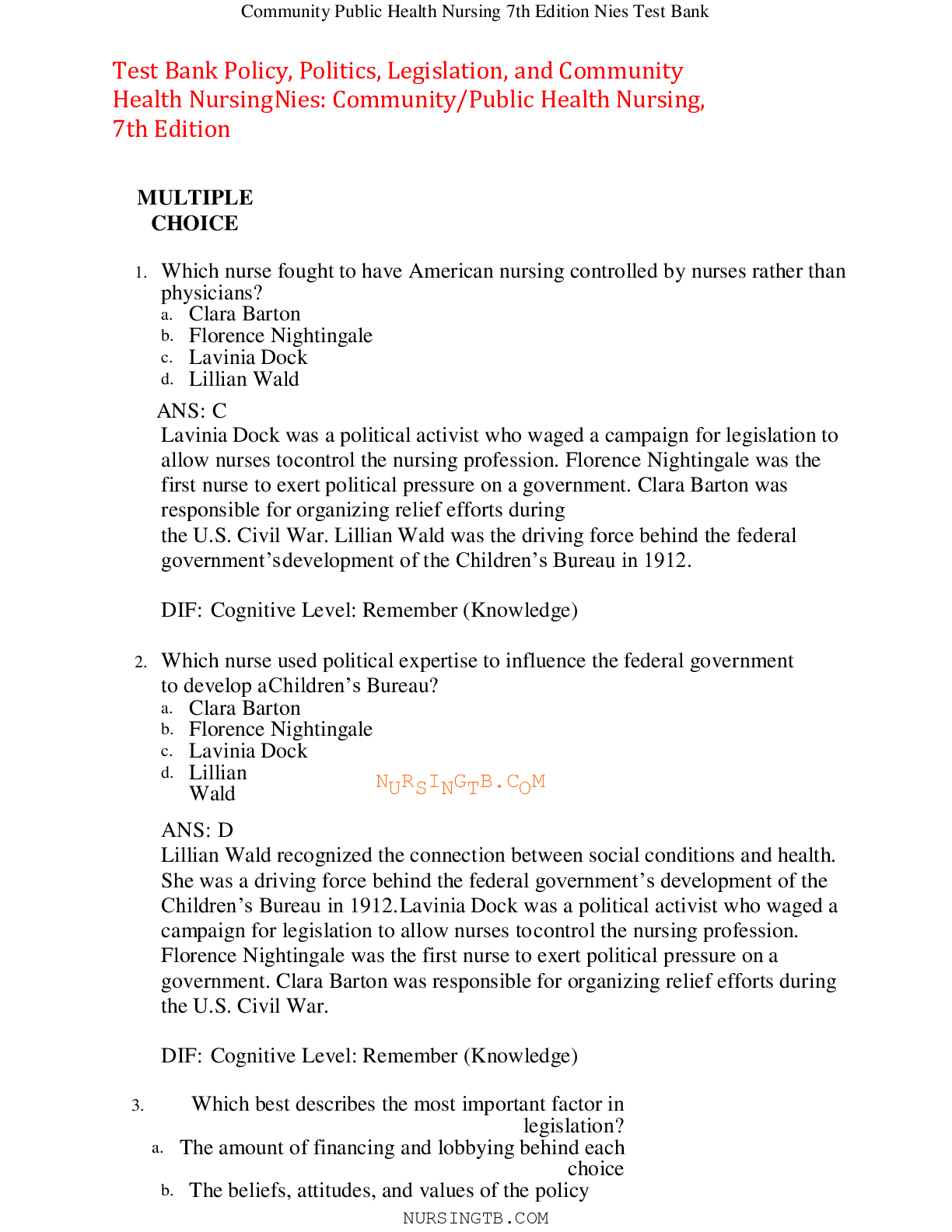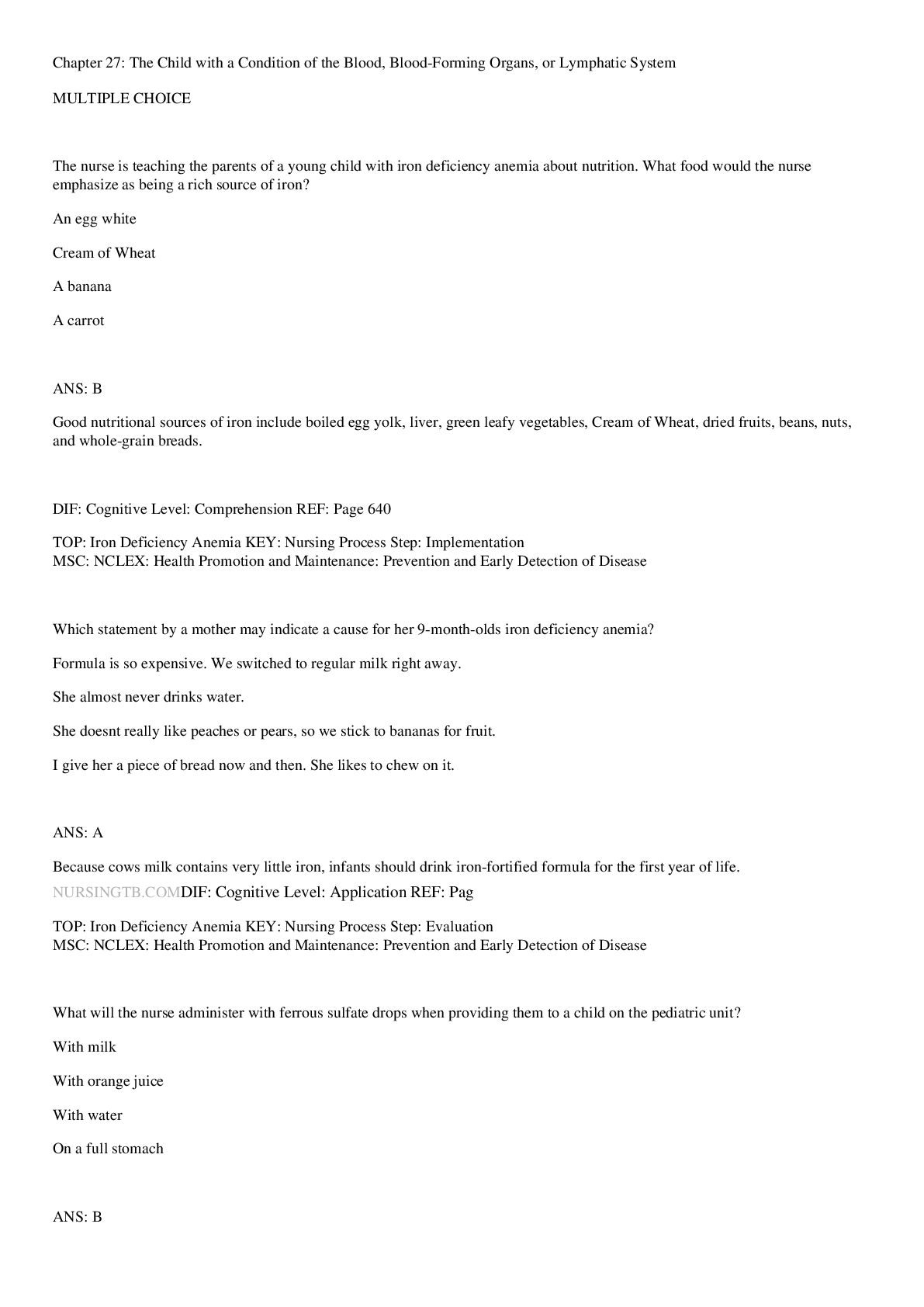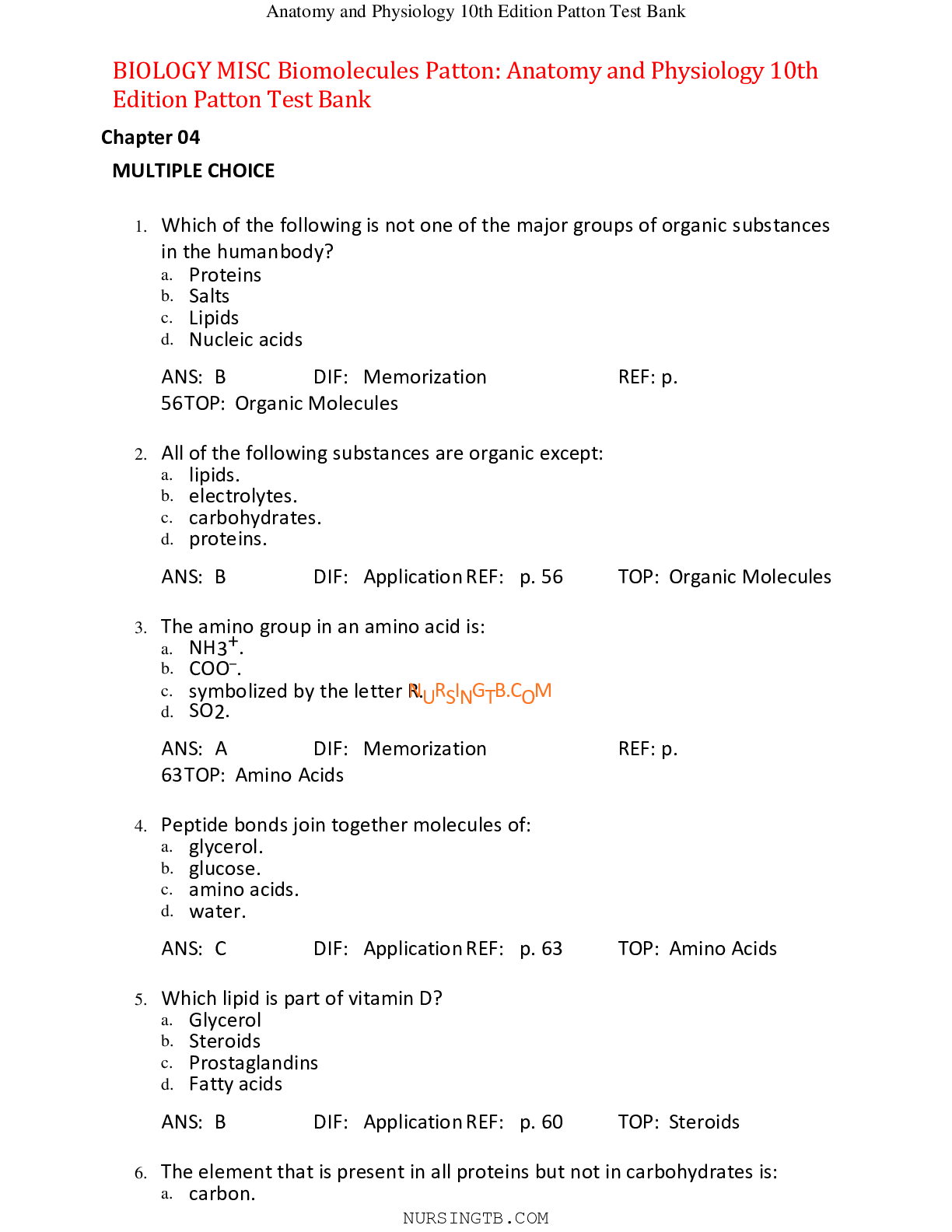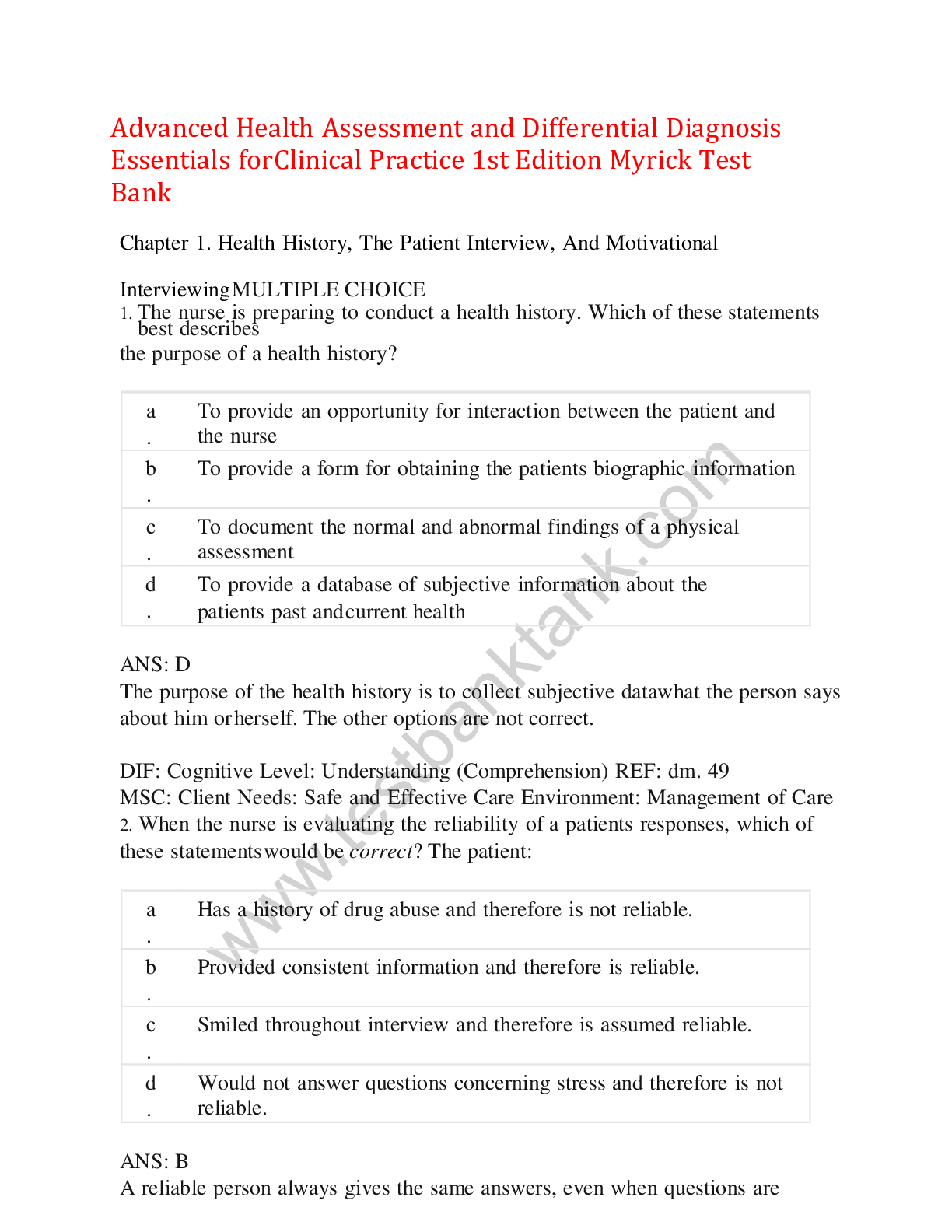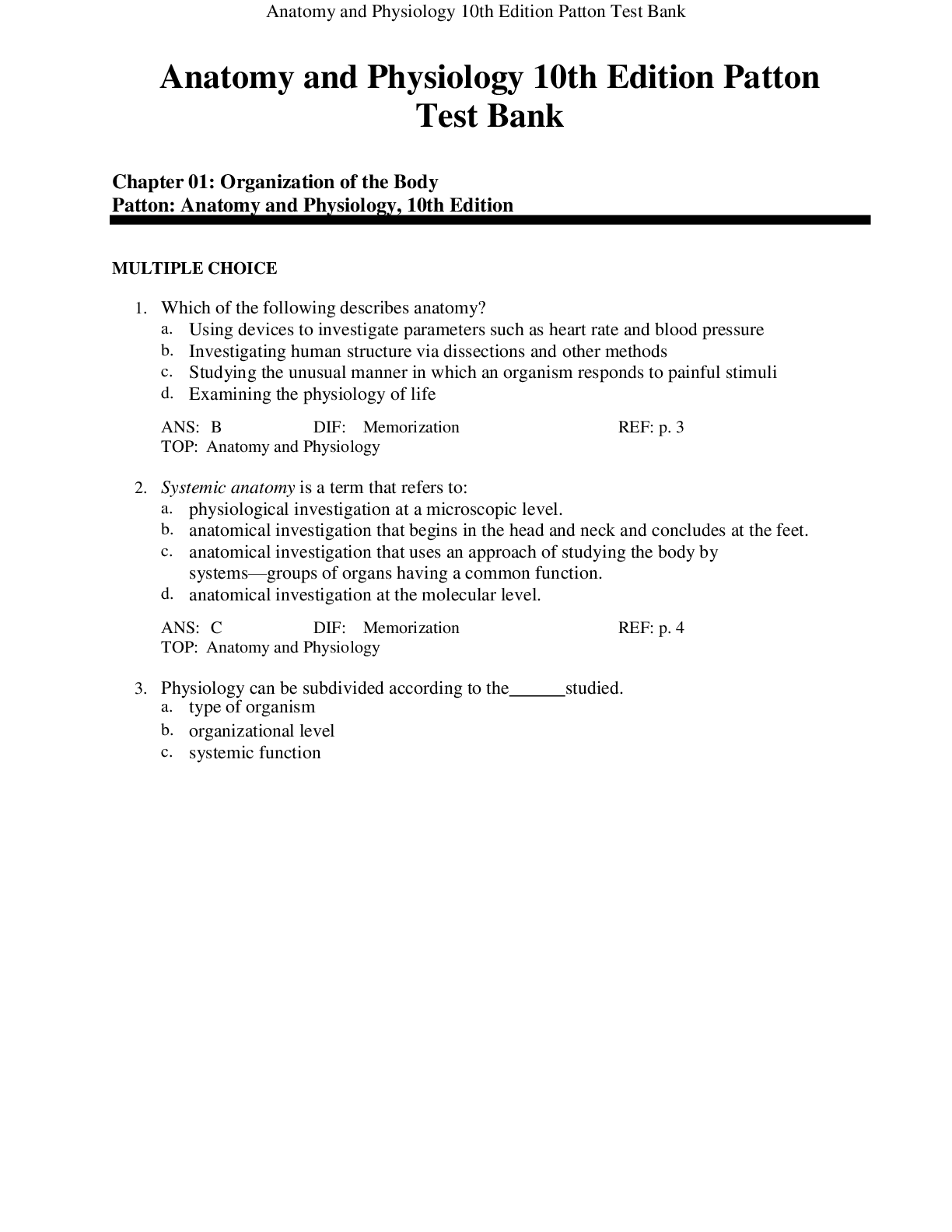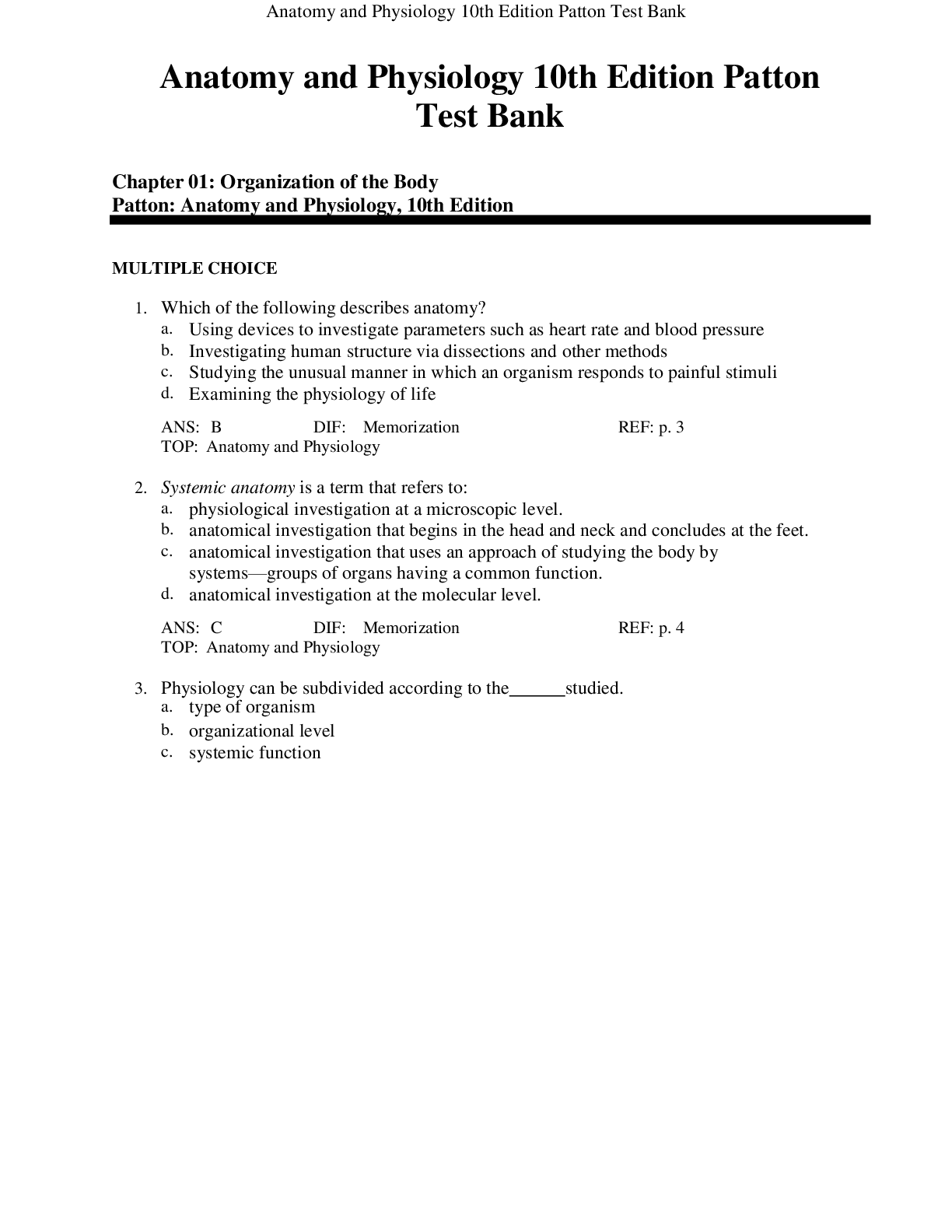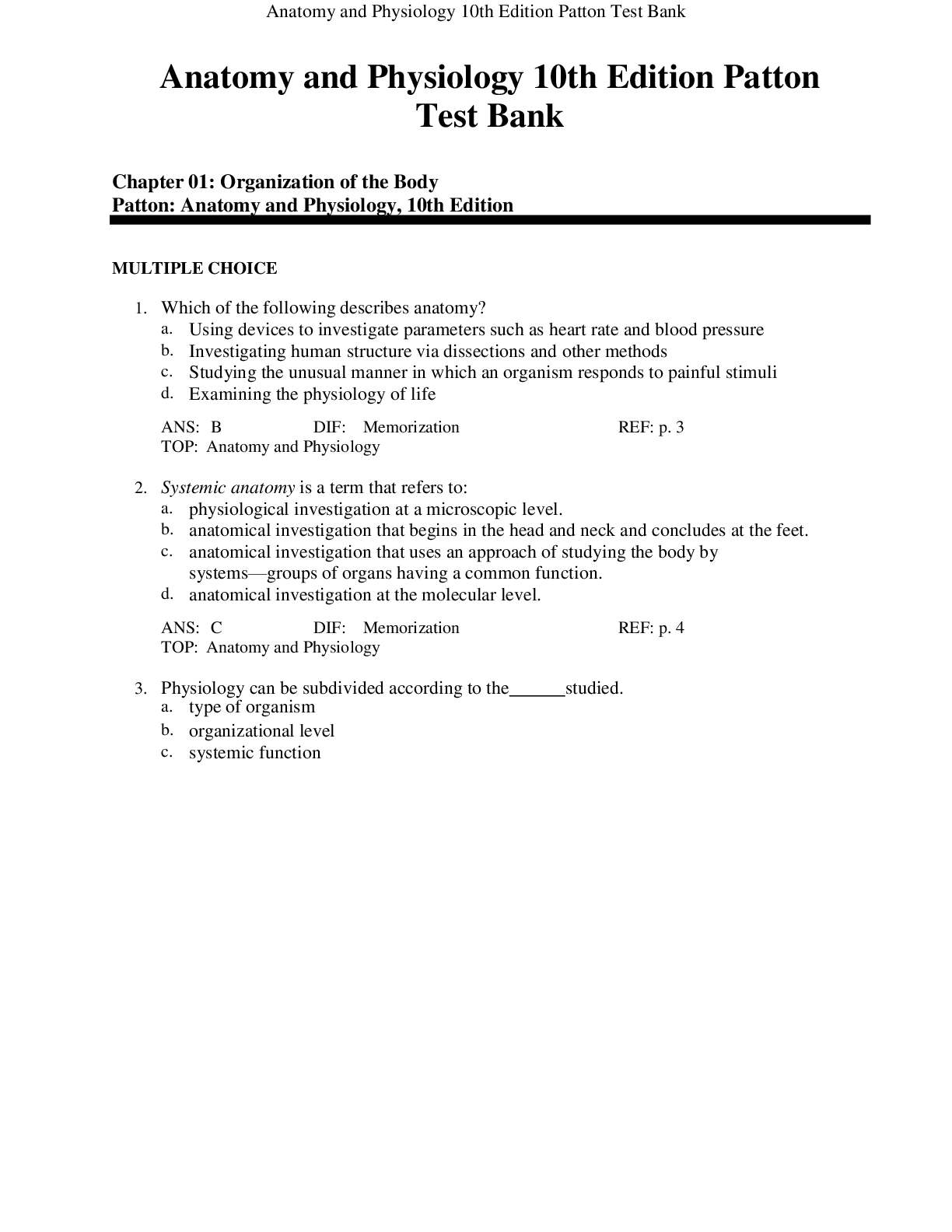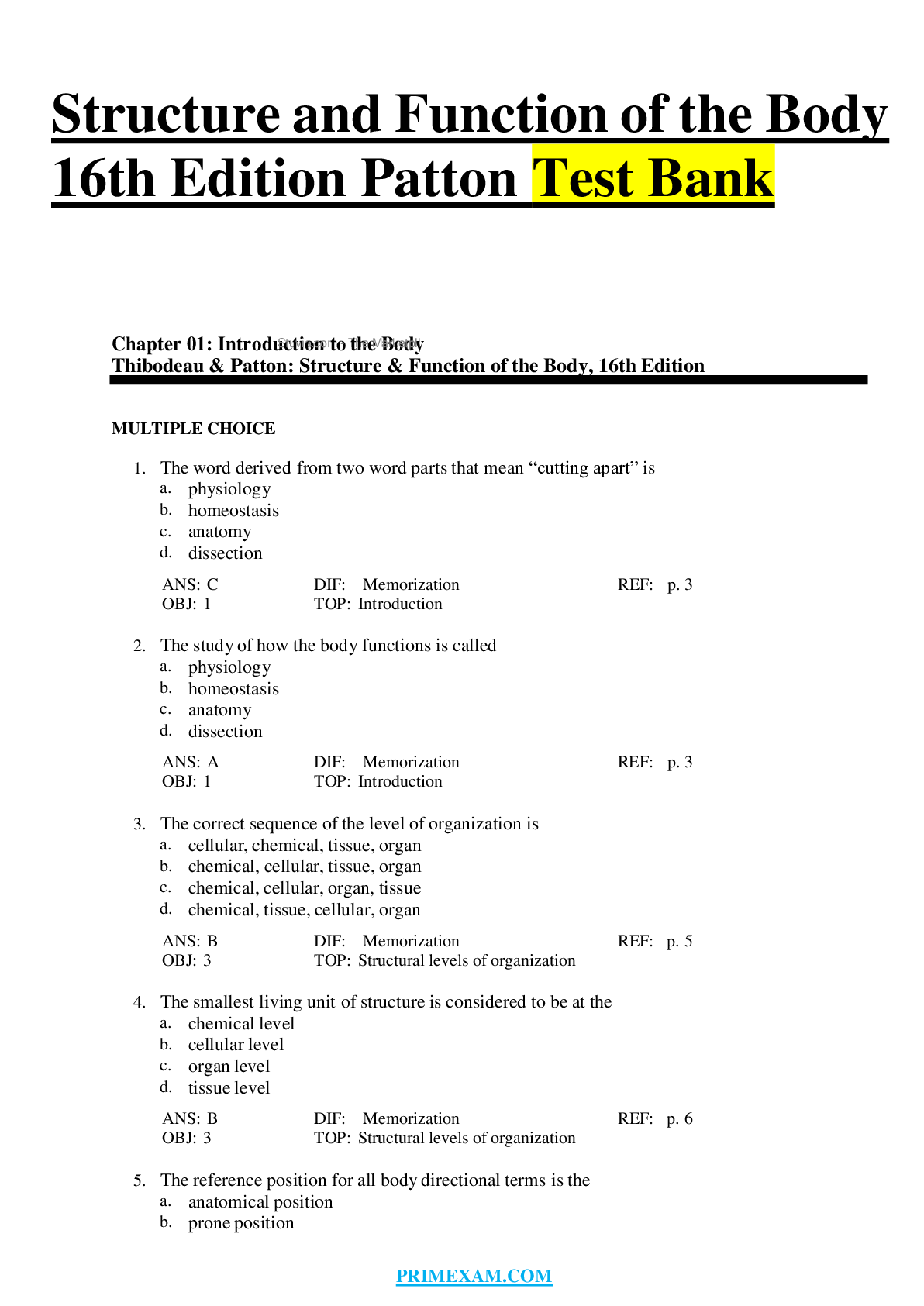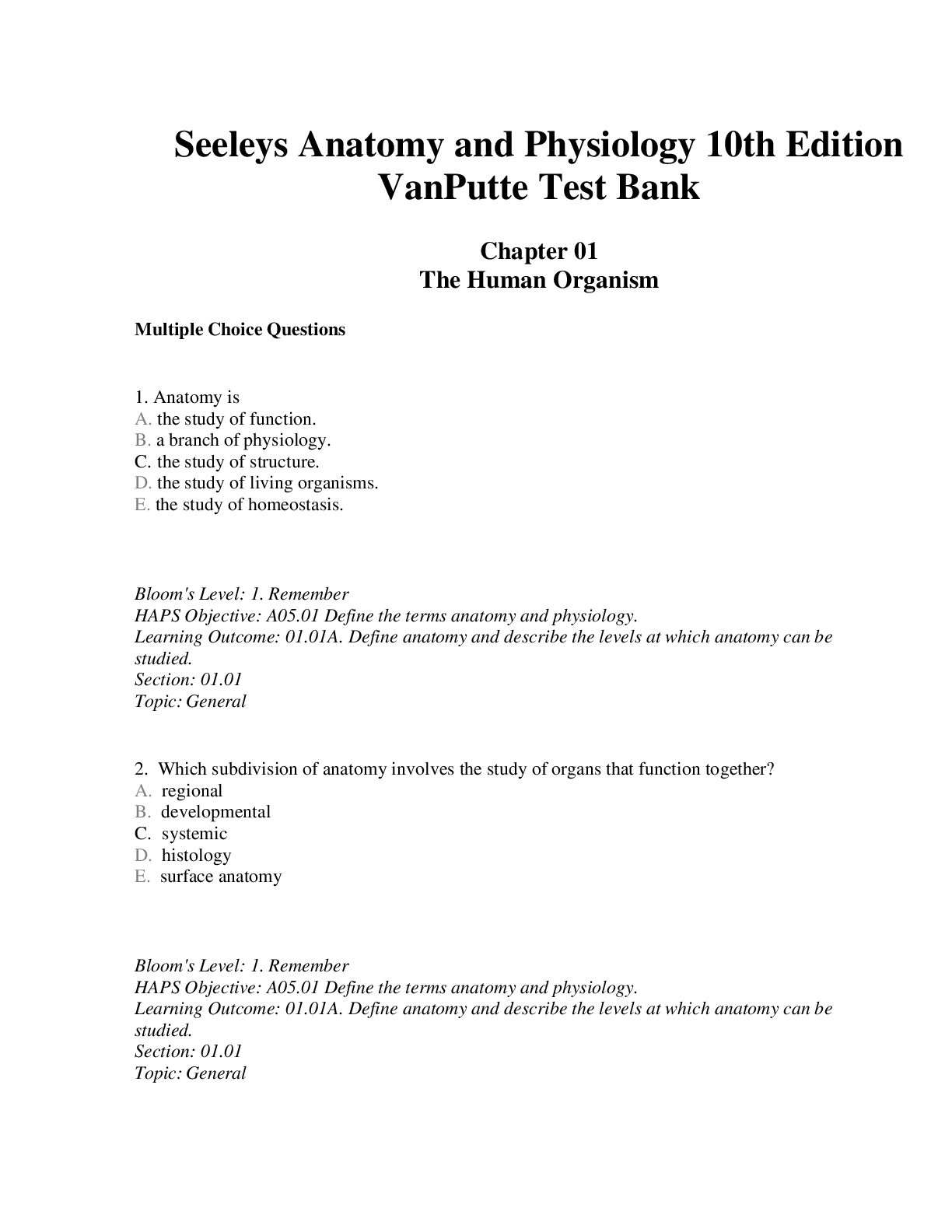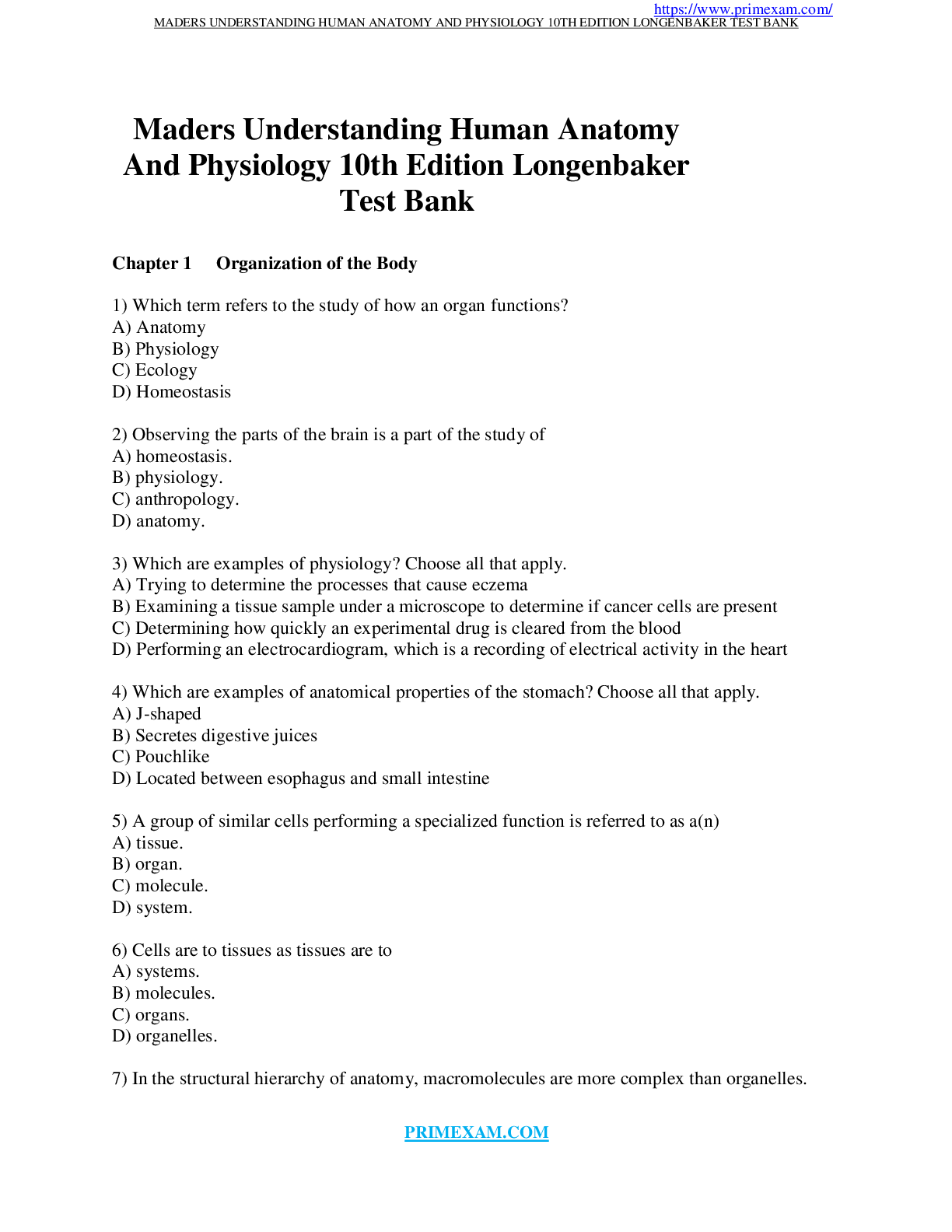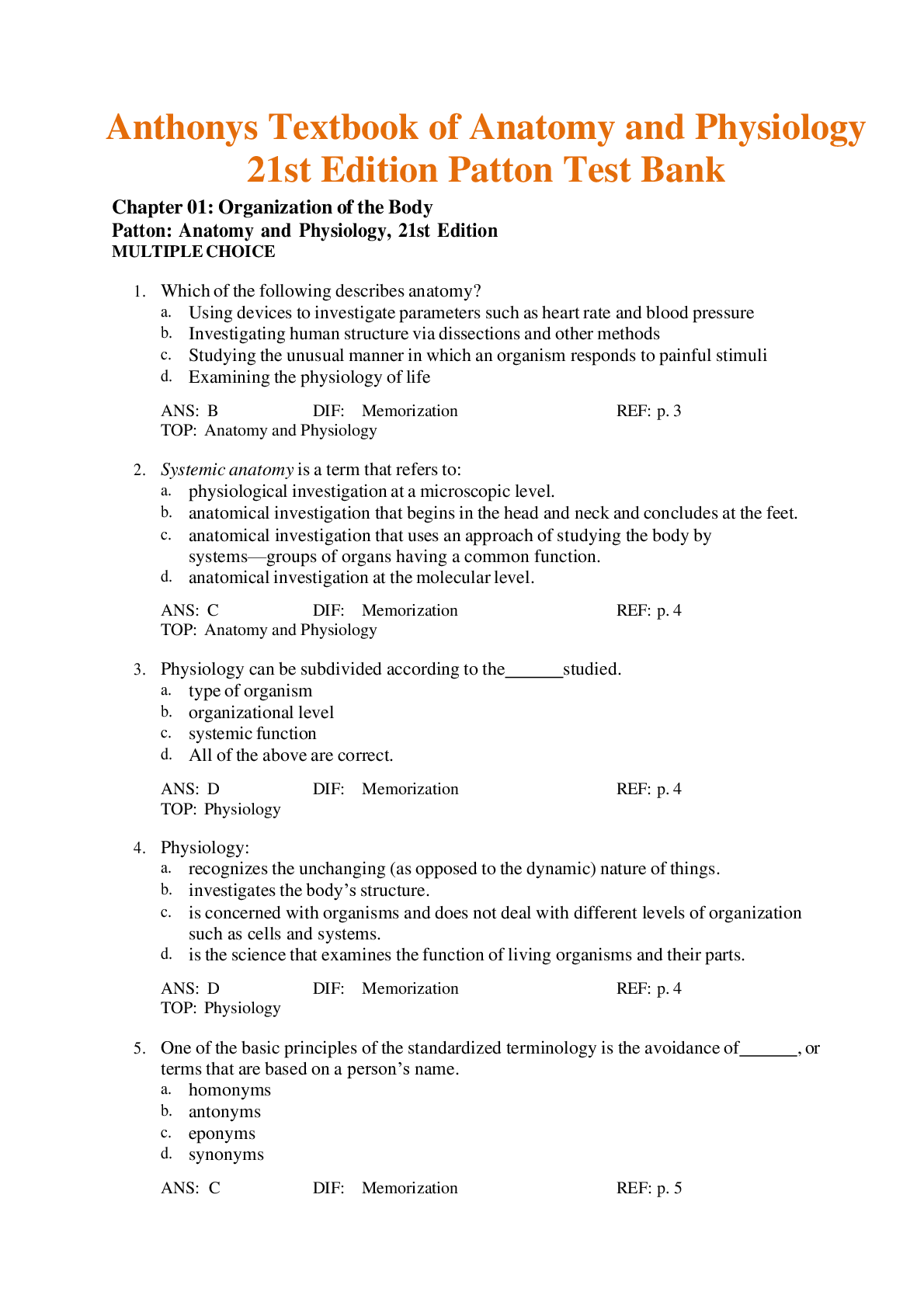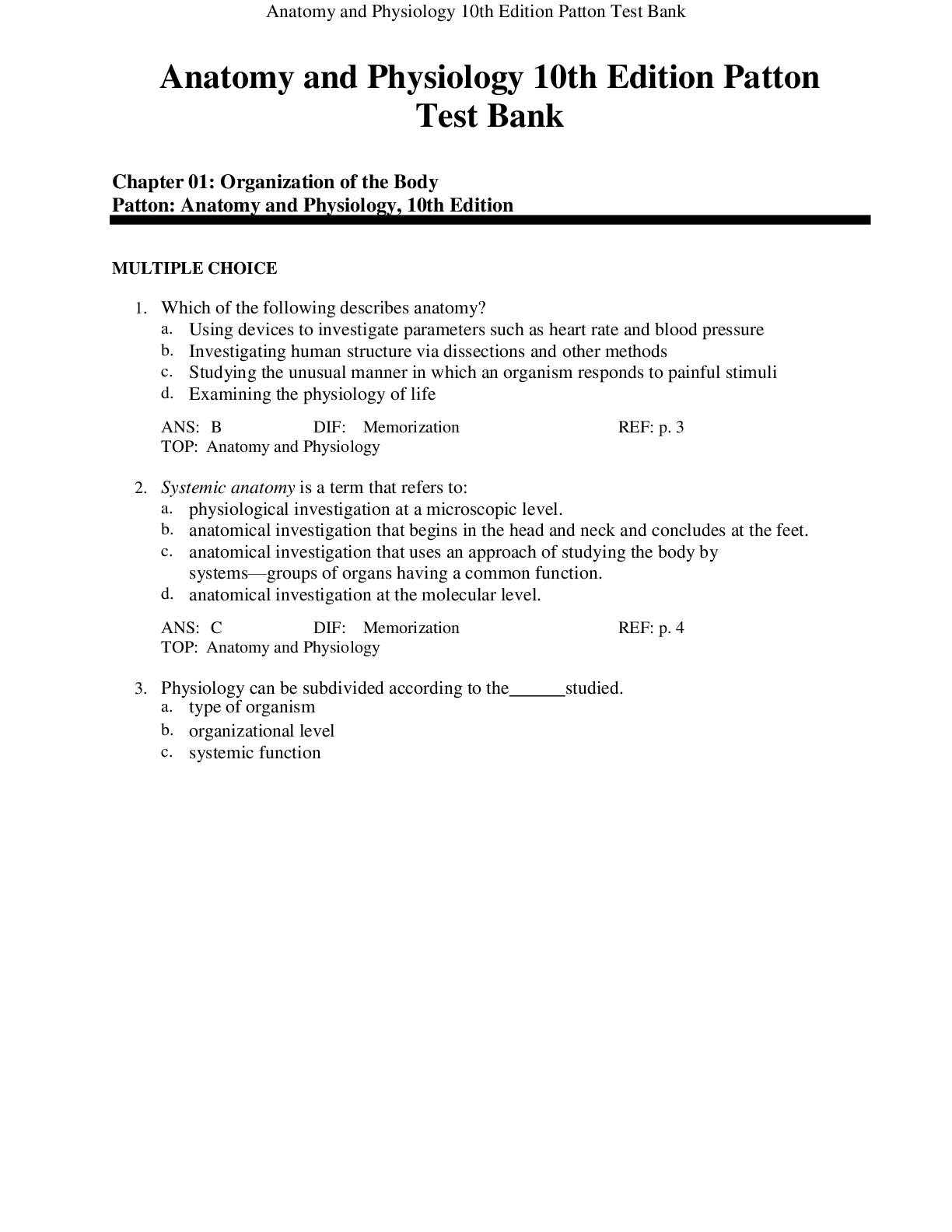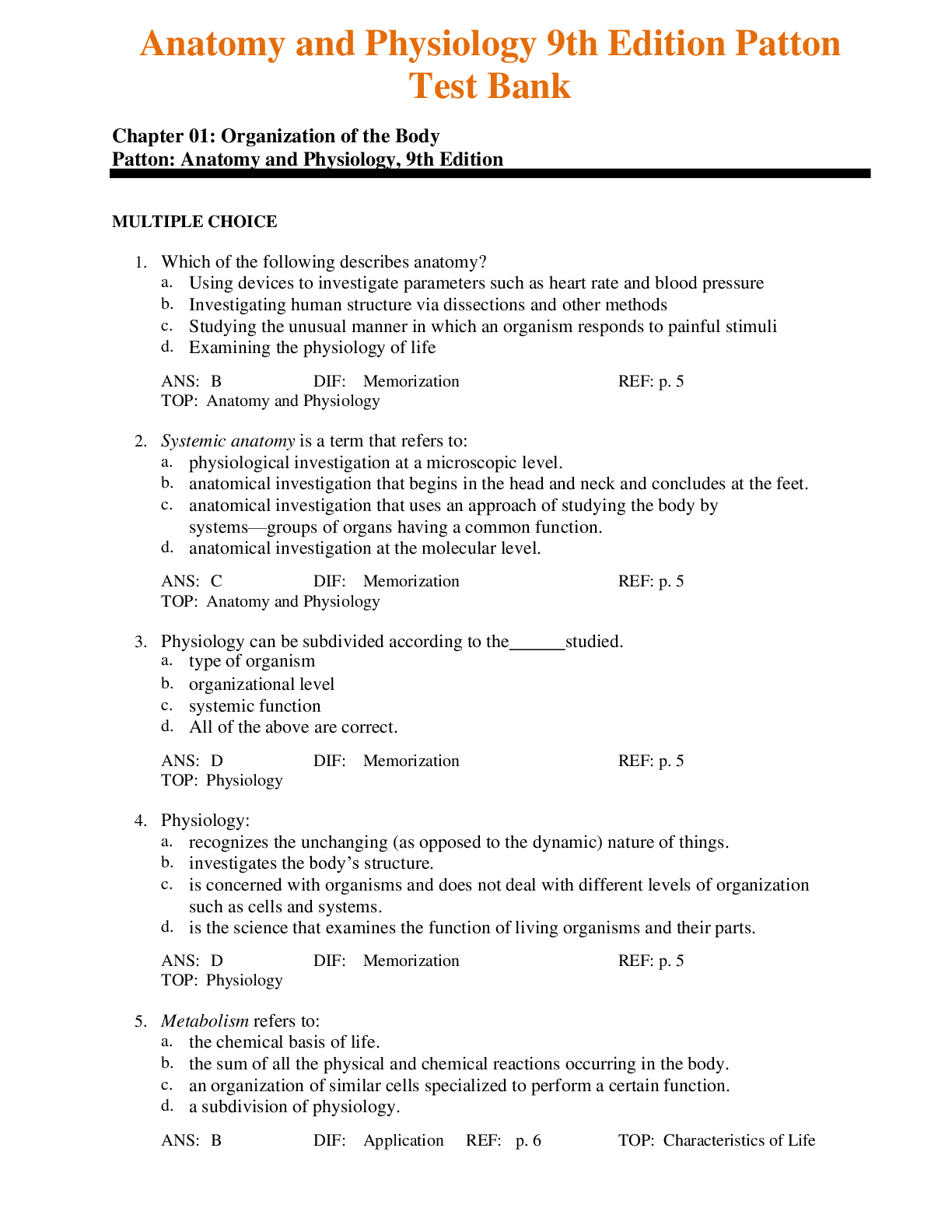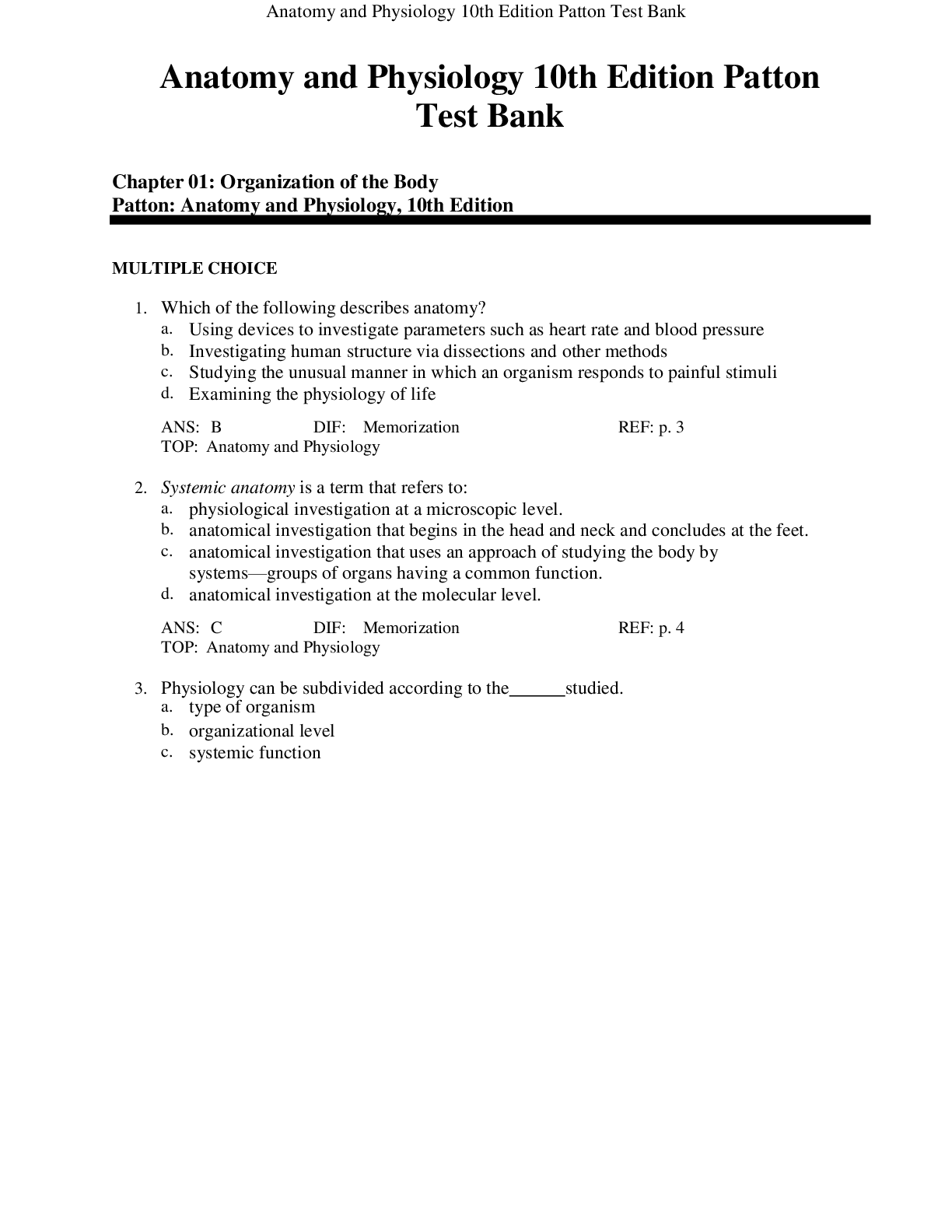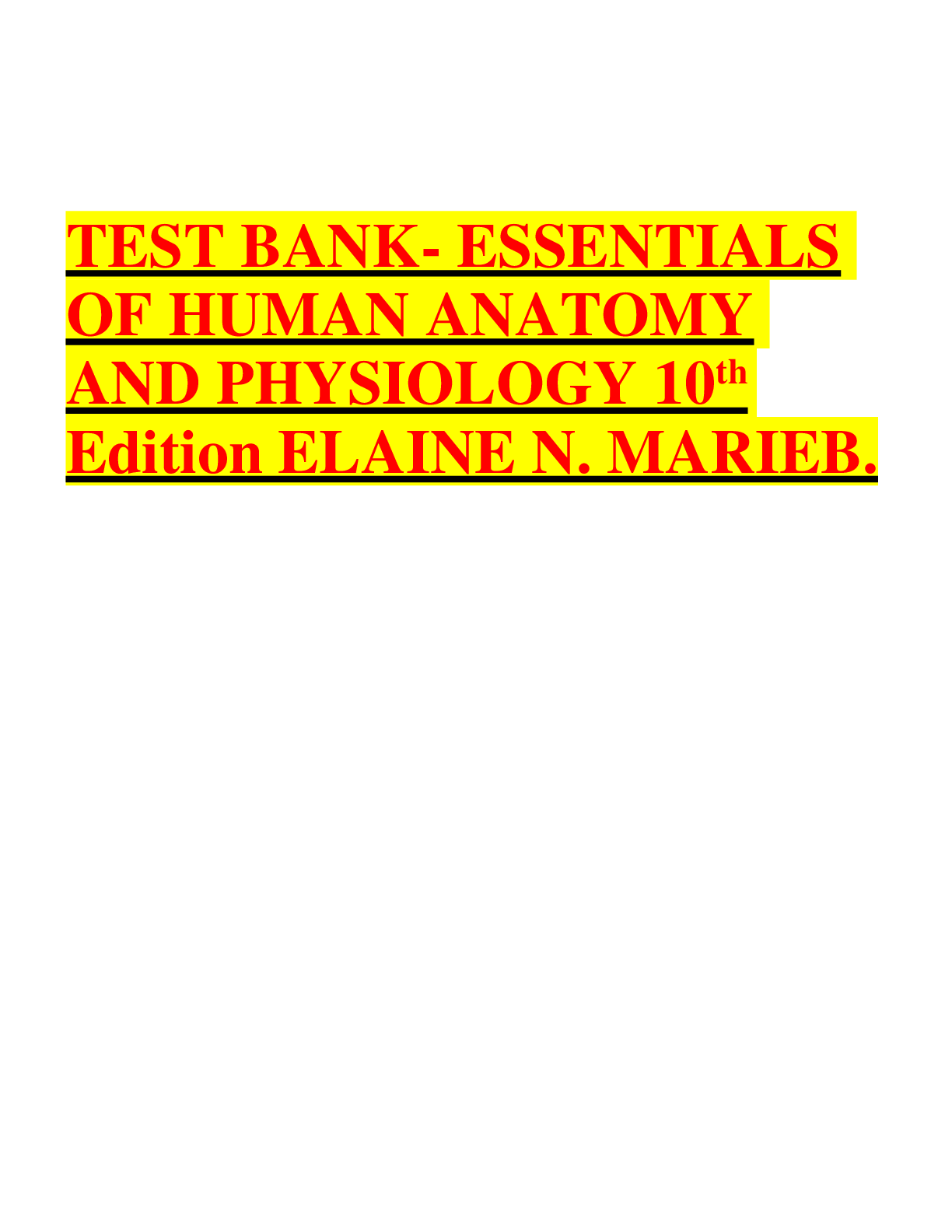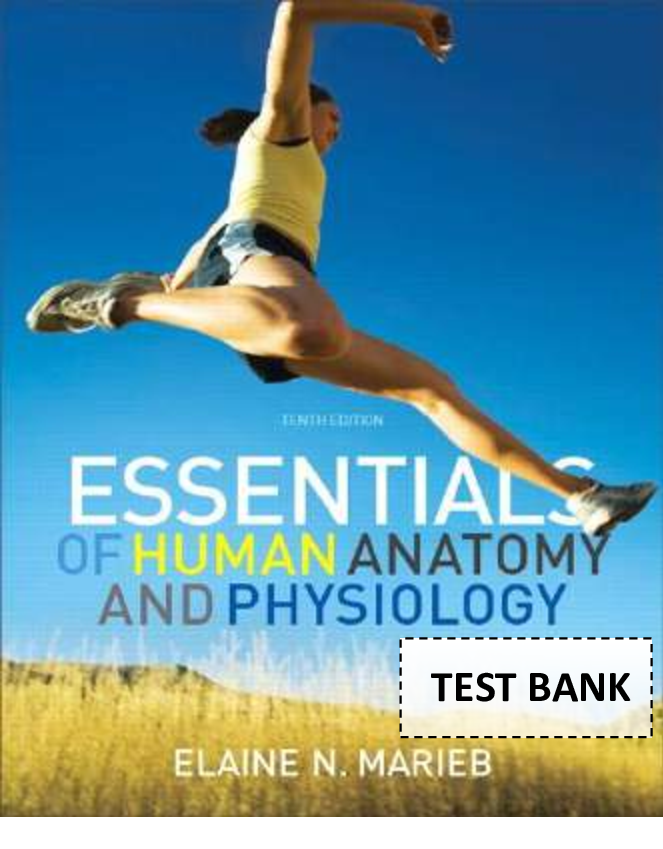*NURSING > TEST BANK > PHYSIOLOGY 10 Organization of the Body Patton: Anatomy and Physiology 10th Edition Patton Test Bank, (All)
PHYSIOLOGY 10 Organization of the Body Patton: Anatomy and Physiology 10th Edition Patton Test Bank,100% CORRECT
Document Content and Description Below
PHYSIOLOGY 10 Organization of the Body Patton: Anatomy and Physiology 10th Edition Patton Test Bank Chapter 01 MULTIPLE CHOICE 1. Which of the following describes anatomy? a. Using devi... ces to investigate parameters such as heart rate and blood pressure b. Investigating human structure via dissections and other methods c. Studying the unusual manner in which an organism responds to painful stimuli d. Examining the physiology of life ANS: B DIF: Memorization REF: p. 3 TOP: Anatomy and Physiology 2. Systemic anatomy is a term that refers to: a. physiological investigation at a microscopic level. b. anatomical investigation that begins in the head and neck and concludes at the feet. c. anatomical investigation that uses an approach of studying the body by systems—groups of organs having a common function. d. anatomical investigation at the molecular level. ANS: C DIF: Memorization REF: p. 4 TOP: Anatomy and Physiology 3. Physiology can be subdivided according to the studied. a. type of organism b. organizational level c. systemic function NURSINGTB.COM d. All of the above are correct. ANS: D DIF: Memorization REF: p. 4 TOP: Physiology 4. Physiology: a. recognizes the unchanging (as opposed to the dynamic) nature of things. b. investigates the body’s structure. c. is concerned with organisms and does not deal with different levels of organization such as cells and systems. d. is the science that examines the function of living organisms and their parts. ANS: D DIF: Memorization REF: p. 4 TOP: Physiology 5. One of the basic principles of the standardized terminology is the avoidance of , or terms that are based on a person’s name. a. homonyms b. antonyms c. eponyms d. synonyms ANS: C DIF: Memorization REF: p. 5 TOP: Language of Science and Medicine 6. Metabolism refers to: a. the chemical basis of life. b. the sum of all the physical and chemical reactions occurring in the body. c. an organization of similar cells specialized to perform a certain function. d. a subdivision of physiology. ANS: B DIF: Application REF: p. 5 TOP: Characteristics of Life 7. From smallest to largest, the levels of organization of the body are: a. organism, chemical, tissue, cellular, organ, system, organelle. b. chemical, microscopic, cellular, tissue, organ, system, organism. c. organism, system, organ, tissue, cellular, organelle, chemical. d. chemical, organelle, cellular, tissue, organ, system, organism. ANS: D DIF: Memorization REF: p. 6 TOP: Levels of Organization 8. The smallest living units of structure and function in the body are: a. molecules. b. cells. c. organelles. d. atoms. ANS: B DIF: Memorization REF: p. 7 TOP: Levels of Organization 9. An organization of many simNilUarRcSelIls NthGatTaBre.sCpeOciMalized to perform a certain function is called a(n): a. tissue. b. organism. c. system. d. organ. ANS: A DIF: Memorization REF: p. 7 TOP: Tissue Level 10. An organ is one organizational level lower than a(n): a. system. b. cell. c. organelle. d. tissue. ANS: A DIF: Memorization REF: p. 7 TOP: Organ Level 11. The reproductive system includes all of the following except the: a. testes. b. ovaries. c. ureter. d. penis. ANS: C DIF: Memorization REF: p. 8 TOP: Body Systems 12. The lungs are located in the: a. thoracic cavity. b. mediastinum. c. abdominal cavity. d. cranial cavity. ANS: A DIF: Memorization REF: p. 12 TOP: Body Cavities 13. The mediastinum contains all of the following except the: a. trachea. b. venae cavae. c. right lung. d. esophagus. ANS: C DIF: Memorization REF: p. 12 TOP: Body Cavities 14. The gallbladder lies in the: a. abdominal cavity. b. pelvic cavity. c. dorsal cavity. d. mediastinum. ANS: A DIF: Memorization REF: p. 13 TOP: Body Cavities NURSINGTB.COM 15. The number of abdominal regions is: a. three. b. five. c. seven. d. nine. ANS: D DIF: Memorization REF: p. 14 TOP: Abdominopelvic Regions 16. The abdominal region in which the urinary bladder is found is the: a. hypogastric. b. epigastric. c. right lumbar. d. left iliac. ANS: A DIF: Memorization REF: p. 15 TOP: Abdominopelvic Regions 17. A surgeon removing a gallbladder should know to find it in the region. a. right lumbar b. right hypochondriac c. hypogastric d. umbilical ANS: B DIF: Memorization REF: p. 14 TOP: Abdominopelvic Regions 18. The abdominal region in which the appendix is found is the: a. hypogastric. b. right iliac. c. right lumbar. d. right hypochondriac. ANS: A DIF: Memorization REF: p. 15 TOP: Abdominopelvic Regions 19. Popliteal refers to the: a. calf. b. ankle. c. cheek. d. area behind the knee. ANS: D DIF: Memorization REF: p. 16 TOP: Latin-based Descriptive Terms for Body Regions 20. A plane through the body that divides the body into right and left sides is called: a. sagittal. b. frontal. c. coronal. d. transverse. ANS: A DIF: MNemoRrizaItionG B.C M TOP: Body Planes and Sections REF: p. 16 21. The abdominal quadrants are located with what structure as their midpoint? a. Umbilicus b. Pubic bone c. Xiphoid process d. Iliac crest ANS: A DIF: Memorization REF: p. 13 TOP: Abdominopelvic Quadrants 22. Humans have similar right and left sides of the body, at least superficially. This is an example of: a. anatomical position. b. anterior symmetry. c. ipsilateral position. d. bilateral symmetry. ANS: D DIF: Memorization REF: p. 8 TOP: Anatomical Position 23. Two major cavities of the human body are: a. ventral/dorsal. b. inferior/superior. c. visceral/parietal. d. axial/appendicular. ANS: A DIF: Memorization REF: p. 9 TOP: Body Cavities 24. The dorsal cavity contains all of the following except the: a. brain. b. spinal column. c. spinal cord. d. thyroid gland. ANS: D DIF: Memorization REF: p. 12 TOP: Body Cavities 25. A plane through the body that divides the body into anterior and posterior portions is: a. sagittal. b. median. c. coronal. d. transverse. ANS: C DIF: Memorization REF: p. 10 TOP: Body Planes and Sections 26. The plane that divides the body into upper and lower parts is the plane. a. sagittal b. frontal c. transverse d. superficial NURSINGTB.COM ANS: C DIF: Memorization REF: p. 11 TOP: Body Planes and Sections 27. A somatotype characterized by having a muscular physique is called a(n): a. endomorph. b. mesomorph. c. ectomorph. d. None of the above is correct. ANS: B DIF: Application REF: p. 17, Connect It TOP: Body Type and Disease 28. A somatotype characterized by a thin, fragile physique is a(n): a. ectomorph. b. mesomorph. c. endomorph. ANS: A DIF: Memorization REF: p. 17, Connect It TOP: Body Type and Disease 29. The abdominopelvic cavity contains all of the following except the: a. kidneys. b. gallbladder. c. right lung. d. urinary bladder. ANS: C DIF: Memorization REF: p. 13 TOP: Body Cavities 30. Which of the following is not one of the characteristics of life? a. Digestion b. Balance c. Conductivity d. Circulation e. Reproduction ANS: B DIF: Memorization REF: p. 5 TOP: Characteristics of Life 31. An idea that is supported by repeated experiments and observation is called a: a. fact. b. theory. c. concept. d. hypothesis. ANS: B DIF: Memorization REF: p. 3 TOP: Science and Society 32. Molecules are: a. atoms combined to form larger chemical aggregates. b. electrons orbiting nuclei.N R I G B.C M c. a complex of electrons arraUngeSd inNconTcentricOshells. d. composed of cellular organelles. ANS: A DIF: Memorization REF: p. 6 TOP: Chemical Level: Basis for Life 33. Mitochondria, Golgi apparatus, and endoplasmic reticulum are examples of: a. molecules. b. cytoplasm. c. organelles. d. plasma membranes. ANS: C DIF: Memorization REF: p. 7 TOP: Levels of Organization 34. When many similar cells specialize to perform a certain function, it is referred to as a(n): a. tissue. b. organelle. c. organ system complex. d. organism. ANS: A DIF: Memorization REF: p. 7 TOP: Tissue Level 35. Several kinds of tissues working together are termed a(n): a. plasma membrane. b. organ. c. organism. d. organ system. ANS: B DIF: Memorization REF: p. 7 TOP: Organ Level 36. Blood production is a function of which system? a. Reproductive b. Respiratory c. Skeletal d. Lymphatic ANS: C DIF: Memorization REF: p. 7 TOP: System Level 37. The dorsal cavity contains the: a. brain and spinal cord. b. heart and lungs. c. reproductive organs. d. digestive organs. ANS: A DIF: Memorization REF: p. 12 TOP: Body Cavities 38. The ventral cavity contains the: a. thoracic and abdominopeNlvicRcavIitieGs. B.C M b. heart and lungs only. U S N T O c. digestive and reproductive organs. d. brain and spinal cord. ANS: A DIF: Memorization REF: p. 12 TOP: Body Cavities 39. The axial portion of the body consists of the: a. arms, neck, and legs. b. neck, torso, and arms. c. torso, arms, legs, and head. d. head, neck, and torso. ANS: D DIF: Memorization REF: p. 15 TOP: Body Regions 40. The abdominopelvic cavity contains all of the following except the: a. stomach. b. pancreas. c. heart. d. reproductive organs. ANS: C DIF: Memorization REF: p. 13 TOP: Body Cavities 41. Visceral peritoneum would cover which of the following organs? a. Heart b. Intestines c. Lungs d. Spinal cord ANS: B DIF: Memorization REF: p. 13 TOP: Body Cavities 42. A sagittal section divides the body into portions. a. upper and lower b. right and left c. front and back d. proximal and distal ANS: B DIF: Memorization REF: p. 10 TOP: Body Planes and Sections 43. A frontal section divides the body into portions. a. upper and lower b. right and left c. front and back d. cortex and medullary ANS: C DIF: Memorization REF: p. 10 TOP: Body Planes and Sections 44. Axilla is a term referring to wNhicRh boIdy GregiBon.?C M a. Anterior elbow b. Armpit c. Posterior knee d. Groin U S N T O ANS: B DIF: Memorization REF: p. 15 TOP: Latin-based Descriptive Terms for Body Regions 45. The tissue is not a major tissue of the body. a. cutaneous b. epithelial c. connective d. nervous ANS: A DIF: Memorization REF: p. 7 TOP: Tissue Level 46. “Apple-shaped” and “pear-shaped” usually describe subtypes of what major body type? a. Mesomorph b. Ectomorph c. Endomorph d. Polymorph ANS: C DIF: Memorization REF: p. 17, Connect It TOP: Body Type and Disease 47. An organ is one organizational level higher than a(n): a. system. b. cell. c. organelle. d. tissue. ANS: D DIF: Memorization REF: p. 7 TOP: Organ Level 48. Which of the following does not describe anatomical position? a. Head pointing forward b. Body standing erect c. Arms extended from the shoulders, palms up d. All of the above describe the body in the anatomical position. ANS: C DIF: Memorization REF: p. 9 TOP: Anatomical Position 49. Someone studying gross anatomy would not study which of the following? a. The location of the heart and chambers of the heart b. Muscles of the arms and legs c. The nucleus of the cell d. All of the above would be studied. ANS: C DIF: Memorization REF: p. 4 TOP: Anatomy 50. The parietal pleura covers theN:URSINGTB.COM a. lungs. b. heart. c. walls of the thoracic cavity. d. Both A and B are correct. ANS: C DIF: Memorization REF: p. 13 TOP: Body Cavities 51. The hollow part of an organ or body structure is called the of the organ. a. cortical part b. lumen c. medullary part d. apical part ANS: B DIF: Memorization REF: p. 9 TOP: Terms Related to Organs 52. The narrowest part of an organ or body structure is called the of the organ. a. cortical part b. lumen c. medullary part d. apical part ANS: D DIF: Memorization REF: p. 10 TOP: Terms Related to Organs 53. Which of the following is not a directional term of the body? a. Apical b. Proximal c. Superficial d. Deep ANS: D DIF: Memorization REF: p. 9 TOP: Terms Related to Organs 54. What is the anatomical direction term that means nearer the surface? a. Deep b. Distal c. Proximal d. Superficial ANS: D DIF: Application REF: p. 9 TOP: Directional Terms 55. An x-ray technician has been asked to make x-ray films of the liver. Which of the abdominopelvic regions must be included? a. Right hypochondriac, epigastric, and left hypochondriac b. Right hypochondriac, right lumbar, and right iliac c. Right iliac, hypogastric, and left iliac d. Right lumbar, umbilical, and left lumbar ANS: A DIF: Application REF: p. 13 TOP: Abdominopelvic Regions 56. As a nurse, you are assisting Na UphRySsiIciNanGwTitBh.thCeOexMamination of a patient. The physician asks you to tell the patient, who is lying on the examination table, to assume the anatomical position. How would you instruct the patient to assume this position? a. Have the patient stand up and place his arms at his sides, palms facing forward, with hands and feet facing forward. b. Have the patient stand up and place his arms at his sides, palms facing posteriorly, with hands and feet facing forward. c. Have the patient stand up and place his arms behind him, palms facing to the side, with feet facing forward. d. Have the patient stand up and place his arms at his sides, palms facing down, with feet facing forward. ANS: A DIF: Application REF: p. 8 TOP: Anatomical Position 57. During a routine physical examination, a patient with an endomorphic somatotype with a large waistline and overall “apple shape” should be advised that such a distribution of fat may lead to what conditions? a. Heart disease, stroke, high blood pressure, and colitis b. Heart disease, stroke, high blood pressure, and diabetes c. Heart disease, stroke, low blood pressure, and colitis d. Prostate cancer, low blood pressure, and diabetes ANS: B DIF: Application REF: p. 17, Connect It TOP: Body Type and Disease 58. If your reference point is “farthest from the trunk of the body” versus “nearest to the trunk of the body,” where does the knee lie in relation to the ankle? a. Distal b. Proximal c. Superficial d. Superior ANS: B DIF: Application REF: p. 9 TOP: Directional Terms 59. The study of microscopic anatomy might include: a. systemic anatomy. b. cytology. c. histology. d. both B and C. ANS: D DIF: Memorization REF: p. 4 TOP: Anatomy 60. The structure that is called the “powerhouse” of the cell is the: a. cytoplasm. b. endoplasmic reticulum. c. mitochondria. d. Golgi apparatus. ANS: C DIF: Memorization REF: p. 7 TOP: Levels of Organization 61. How many main tissue typesNaUreRfoSuIndNiGn TthBe .huCmOaMn body? a. 4 b. 8 c. 11 d. 6 ANS: A DIF: Memorization REF: p. 7 TOP: Levels of Organization 62. The mediastinum is located in the cavity. a. dorsal b. abdominal c. ventral d. Both B and C are correct. ANS: C DIF: Application REF: p. 12 TOP: Body Cavities 63. Another term for posterior is: a. ventral. b. dorsal. c. inferior. d. proximal. ANS: B DIF: Memorization REF: p. 9 TOP: Directional Terms 64. The term most nearly opposite cortical would be: a. peripheral. b. apical. c. medullary. d. basal. ANS: C DIF: Memorization REF: p. 9 TOP: Terms Related to Organs 65. Withdrawing from a painful stimulus is an example of: a. excretion. b. growth. c. responsiveness. d. secretion. ANS: C DIF: Application REF: p. 5 TOP: Characteristics of Life MATCHING Match each organ to its corresponding system. a. Respiratory b. Digestive c. Urinary d. Reproductive e. Endocrine f. Cardiovascular g. Integumentary h. Muscular i. Skeletal j. Nervous 1. Tendons 2. Pituitary gland 3. Skin 4. Capillaries 5. Ligaments 6. Spinal cord 7. Bronchial tree 8. Testes and ovaries 9. Large and small intestines 10. Ureters NURSINGTB.COM 1. ANS: TOP: H Body Systems DIF: Memorization REF: p. 8, Table 1-2 2. ANS: TOP: E Body Systems DIF: Memorization REF: p. 8, Table 1-2 3. ANS: TOP: G Body Systems DIF: Memorization REF: p. 8, Table 1-2 4. ANS: F DIF: Memorization REF: p. 8, Table 1-2 TOP: Body Systems 5. ANS: TOP: I Body Systems DIF: Memorization REF: p. 8, Table 1-2 6. ANS: TOP: J Body Systems DIF: Memorization REF: p. 8, Table 1-2 7. ANS: TOP: A Body Systems DIF: Memorization REF: p. 8, Table 1-2 8. ANS: TOP: D Body Systems DIF: Memorization REF: p. 8, Table 1-2 9. ANS: TOP: B Body Systems DIF: Memorization REF: p. 8, Table 1-2 10. ANS: TOP: C Body Systems DIF: Memorization REF: p. 8, Table 1-2 Match each term to its associated region. a. Abdominal b. Brachial c. Cervical d. Coxal e. Cutaneous f. Digital g. Femoral h. Lumbar 11. Thigh 12. Arm 13. Anterior torso NURSINGTB.COM 14. Lower back between ribs and pelvis 15. Fingers and toes 16. Hip 17. Skin 18. Neck 11. ANS: TOP: G Body Regions DIF: Memorization REF: p. 16, Table 1-4 12. ANS: TOP: B Body Regions DIF: Memorization REF: p. 16, Table 1-4 13. ANS: TOP: A Body Regions DIF: Memorization REF: p. 16, Table 1-4 14. ANS: TOP: H Body Regions DIF: Memorization REF: p. 16, Table 1-4 15. ANS: TOP: F Body Regions DIF: Memorization REF: p. 16, Table 1-4 16. ANS: TOP: D Body Regions DIF: Memorization REF: p. 16, Table 1-4 17. ANS: TOP: E Body Regions DIF: Memorization REF: p. 16, Table 1-4 18. ANS: TOP: C Body Regions DIF: Memorization REF: p. 16, Table 1-4 Match each term to its correct corresponding statement. a. Superior b. Inferior c. Anterior d. Posterior e. Medial f. Lateral g. Proximal h. Distal i. Superficial 19. The great toe is to the little toe. 20. The skin is to the muscles beneath it. 21. The vertebrae are located on the aspect of the body. 22. The hand is to the shoulder. 23. The abdomen is to the head. 24. The lungs are to the intestines. 25. The nose is located on the surface of the head. 26. The knee is to the ankle. 27. The ear is on the aspect of the head. NURSINGTB.COM Match each set of functions with its corresponding system or systems. a. Reproduction and development b. Processing, regulation, and maintenance c. Outer protection d. Support and movement e. Communication, control, and integration f. Transportation and defense 28. Nervous system 29. Muscular system and skeletal system 30. Circulatory system and lymphatic system 31. Respiratory system, digestive system, and endocrine system 32. Reproductive system 33. Integumentary system 28. ANS: TOP: E Body Systems DIF: Memorization REF: p. 8, Table 1-2 29. ANS: TOP: D Body Systems DIF: Memorization REF: p. 8, Table 1-2 30. ANS: TOP: F Body Systems DIF: Memorization REF: p. 8, Table 1-2 31. ANS: TOP: B Body Systems DIF: Memorization REF: p. 8, Table 1-2 32. ANS: TOP: A Body Systems DIF: Memorization REF: p. 8, Table 1-2 33. ANS: TOP: C Body Systems DIF: Memorization REF: p. 8, Table 1-2 Match each characteristic of life with the correct descriptive phrase. a. Conductivity b. Excretion c. Growth d. Circulation e. Respiration f. Responsiveness g. Digestion h. Absorption i. Secretion j. Reproduction NURSINGTB.COM 34. Movement of digested nutrients through the wall of the digestive tract into body fluids for transport to the cell 35. Permits an organism to sense, monitor, and respond to changes in the external environment 36. Production and release of specialized substances to support diverse body functions 37. Responsiveness and this characteristic are highly developed in nerve cells 38. Movement of body fluids and other substances from one part of the body to another 39. Removal of waste produced by many body functions 40. Comes about as a result of a normal increase in size or number of cells 41. Exchange of gases between the organism and the environment 42. Formation of new individuals 43. Process by which complex food substances are broken down into simple substances that can be absorbed by the cells 34. ANS: TOP: H Characteristics DIF: Memorization of Life REF: p. 5, Table 1-1 35. ANS: TOP: F Characteristics DIF: Memorization of Life REF: p. 5, Table 1-1 36. ANS: TOP: I Characteristics DIF: Memorization of Life REF: p. 5, Table 1-1 37. ANS: A DIF: Memorization REF: p. 5, Table 1-1 TOP: Characteristics of Life 38. ANS: TOP: D DIF: Memorization Characteristics of Life REF: p. 5, Table 1-1 39. ANS: TOP: B DIF: Memorization Characteristics of Life REF: p. 5, Table 1-1 40. ANS: TOP: C DIF: Memorization Characteristics of Life REF: p. 5, Table 1-1 41. ANS: TOP: E DIF: Memorization Characteristics of Life REF: p. 5, Table 1-1 42. ANS: TOP: J DIF: Memorization Characteristics of Life REF: p. 5, Table 1-1 43. ANS: TOP: G DIF: Memorization Characteristics of Life REF: p. 5, Table 1-1 Match each term related to an organ to its definition or explanation. a. Medullary b. Basal c. Apical d. Cortical e. Lumen 44. Base or widest part of the organ 45. Outer region or layer of an organ 46. Hollow part of an organ or tube of the body 47. Inner region of an organ 48. Narrow part or point of an organ 44. ANS: TOP: B DIF: MNemUoRriSzaItioNnGTB.COM REF: Terms Related to Organs p. 10 45. ANS: TOP: D DIF: Memorization Terms Related to Organs REF: p. 9 46. ANS: TOP: E DIF: Memorization Terms Related to Organs REF: p. 9 47. ANS: TOP: A DIF: Memorization Terms Related to Organs REF: p. 9 48. ANS: TOP: C DIF: Memorization Terms Related to Organs REF: p. 10 Match each level of organization with its description. a. Chemical b. Organelle c. Cellular d. Tissue e. Organ f. System g. Organism 49. Highest level of organization 50. Includes mitochondria 51. Composed of the smallest structure that possesses the basic characteristics of living matter 52. Level at which the tissues work together to perform a specific function 53. Composed of macromolecules 54. Cells working together to perform a specific function 55. Level at which a group of organs work together to perform specific complex functions 49. ANS: TOP: G Levels of DIF: Memorization Organization REF: p. 8 50. ANS: TOP: B Levels of DIF: Memorization Organization REF: p. 7 51. ANS: TOP: C Levels of DIF: Memorization Organization REF: p. 7 52. ANS: TOP: E Levels of DIF: Memorization Organization REF: p. 7 53. ANS: TOP: A Levels of DIF: Memorization Organization REF: p. 6 54. ANS: TOP: D Levels of DIF: Memorization Organization REF: p. 7 55. ANS: TOP: F Levels of DIF: Memorization Organization REF: p. 7 OTHER 1. In simple terms, what are the characteristics of life? ANS: Answers will vary. DIF: Application REF: p.N5URSINGTTOBP:.CChOarMacteristics of Life 2. Discuss the principle of complementarity of structure and function. ANS: Answers will vary. DIF: Application REF: p. 16 TOP: Interaction of Structure and Function 3. Explain one way in which culture has affected science. Explain one way in which science has affected culture. ANS: Answers will vary. DIF: Application REF: p. 3 TOP: Science and Society 4. Describe the levels of organization from chemical to system. ANS: Answers will vary. DIF: Memorization REF: p. 6 TOP: Levels of Organization 5. Describe anatomical position. Give examples of structures that are ipsilateral and contralateral to each other. ANS: Answers will vary. DIF: Application REF: p. 8 TOP: Anatomical Position 6. List the directional terms, and use them to describe the relationship between two structures in the body. ANS: Answers will vary. DIF: Application REF: p. 9 TOP: Anatomical Directions NURSINGTB.COM [Show More]
Last updated: 1 year ago
Preview 1 out of 33 pages

Reviews( 0 )
Document information
Connected school, study & course
About the document
Uploaded On
Dec 20, 2022
Number of pages
33
Written in
Additional information
This document has been written for:
Uploaded
Dec 20, 2022
Downloads
0
Views
45

